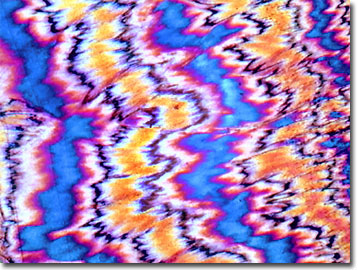Polarized Light Digital Image Gallery
Testosterone
Testosterone is the major steroidal hormone produced by the interstitial cells of Leydig in the male testes. Lesser amounts of this hormone are produced in the adrenal glands of both sexes. Synthetic testosterone forms a white or slightly creamy white crystalline powder or crystals that are practically insoluble in water and freely soluble in alcohol, chloroform, and vegetable oils. Odorless, crystalline testosterone melts from 153 to 157 degrees Celsius.

View a second image of testosterone.
The male androgens, including testosterone, are responsible for spermatogenesis, sexual differentiation, development of secondary sexual characteristics, and male pattern baldness. The dreaded cholesterol is the immediate precursor of gonadal steroids and the daily secretion rate for the average adult man is about 5 milligrams. In the blood, testosterone is carried by a plasma protein known as sex hormone binding globulin. Only about 2 percent of the circulating testosterone is able to enter cells and exert its metabolic effects, while most is metabolized to 17-ketosteroids in the liver, and after transformation to sulfate or glucuronide, is excreted in the urine. In addition to metabolic and physical changes linked to testosterone's action, behavioral changes including aggression initiate at puberty. Surprisingly, because of a steroid feedback loop, exogenous testosterone may actually result in a decrease in sperm count.
Formerly known as androsterone, Nobel Laureate Adolf Friedrich Johann Butenandt (1939 in Chemistry) first isolated testosterone as a chloroform extract from male urine. He found that the crystalline substance, with the physiological properties of a male sex hormone, had some similarities with the female sex hormone estrogen. Based on the molecular structure of cholesterol, Butenandt outlined the formula for testosterone in 1934. Independently, Dr. Leopold Ruzicka, the Croatian co-winner of the chemistry award in 1939, synthesized androsterone from epi-cholestanol. Because of political pressure associated with the beginning of World War II, Dr. Butenandt, a German biochemist, did not receive his gold medal and diploma until 1949.
Contributing Authors
Omar Alvarado, Thomas J. Fellers and Michael W. Davidson - National High Magnetic Field Laboratory, 1800 East Paul Dirac Dr., The Florida State University, Tallahassee, Florida, 32310.
BACK TO THE POLARIZED LIGHT IMAGE GALLERY
BACK TO THE DIGITAL IMAGE GALLERIES
Questions or comments? Send us an email.
© 1995-2025 by Michael W. Davidson and The Florida State University. All Rights Reserved. No images, graphics, software, scripts, or applets may be reproduced or used in any manner without permission from the copyright holders. Use of this website means you agree to all of the Legal Terms and Conditions set forth by the owners.
This website is maintained by our
Graphics & Web Programming Team
in collaboration with Optical Microscopy at the
National High Magnetic Field Laboratory.
Last Modification Friday, Nov 13, 2015 at 01:19 PM
Access Count Since September 17, 2002: 13670
Visit the website of our partner in introductory microscopy education:
|
|
